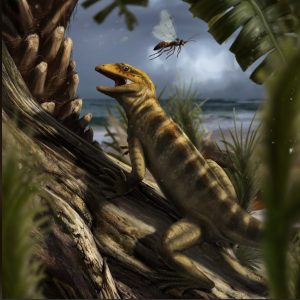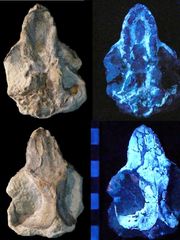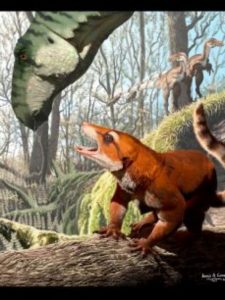Two new fossils have been discovered recently of new species that are both very important in our understanding of the evolutionary history of life on our planet. Following the rule of age before beauty I’ll begin by discussing the earliest known ancestor of the group of reptiles known as the lizards.
Most people know lizards as simply any reptile that obviously isn’t either a crocodile or a turtle or a snake but lizards are actually the largest family of reptiles having over 6,000 species. Lizards range in size from tiny geckoes only a couple of centimeters long to the Komodo dragon that can exceed 3m in length.
The ‘new’ species has been named Megachirella wachtleri and the specimen was actually found twenty years ago in the Dolomites region of Northern Italy. As is the case with many recent fossil discoveries it was only when M. wachtleri was re-examined with new, more powerful instruments, a CT scan in the instance, that the features of M. wachtleri that made it important could be seen. The image below shows the fossil of Megachirella wachtleri.

The study of M. wachtleri was co-authored by Tiago Simoes of the University of Alberta in Canada who had spent more than 400 days visiting over 50 university and museum fossil collections in 17 different countries. Doctor Simoes is one of a number of researchers making important discoveries among the forgotten and misidentified specimens locked away in museum drawers.
Megachirella wachtleri lived some 240 million years ago making it the oldest fossil lizard by about 75 million years. Just as importantly, since M. wachtleri shows so many classic lizard features it probably pushes the common ancestor of lizards and other reptiles back to more than 252 million years.
Why is that important? Well you see 252 million years ago was the Permian / Triassic extinction when more than 95% of all of the different species of living creatures vanished. If the lizards split off from the other reptiles before then that means that at least one species of lizard survived the Permian extinction. The image below shows an artist’s impression of what M. wachtleri looked like.

Our second discovery this month comes from a fossil site in the state of Utah and consists of a well preserved skull of an early relative of the mammals from an extinct group known as the haramiyidan. Named Cifelliodon wahkarmoosuch the fossil is thought to be between 139 and 124 million years old. The image below shows the fossil skull.

As I mentioned above the haramiyidan were a group of creatures that broke away from the reptiles at about the same time as the mammals and which share certain characteristics with our ancestors such as hairy fur but which retained other reptilian characteristics like giving birth via eggs. The exact nature of haramiyidans is still largely unknown since the group of animals did not last long and most of what we know comes from fossil teeth. Larger bones and especially skulls are often so smashed that little can be learned from them.
Paleontologists appear to have gotten lucky this time because the skull of C. wahkarmoosuch was well preserved enough to reveal an enormous amount of detail under X-rays and CT scans. Again, we see how newer more sophisticated instruments are leading to ever more discoveries! The excellent preservation of the fossil was despite the fact that the skull of C. wahkarmoosuch was found beneath the foot of a new species of iguanodon type dinosaur named Hippodraco.
C. wahkarmoosuch was a very small animal, less than 15 centimeters in length and weighing little more than a kilo. Based upon an examination of its eye sockets and large olfactory cavities the animal probably had poor eyesight but a very good sense of smell. The image below shows an artist’s impression of what C. wahkarmoosuch may have looked like.

With every new discovery we are filling in the details of the tree of life and finding it to be far more complex and detailed than we had ever imagined.

Hello, every time i used to check web site posts here early in the break of day, since i like to gain knowledge of more and more.
Thanks for the comment and come back soon!
Bob L
Heya i am for the first time here. I found this board and I
in finding It truly useful & it helped me out much.
I am hoping to give one thing back and help others such as you helped me.
Thanks for the comment and come back soon!
Bob L